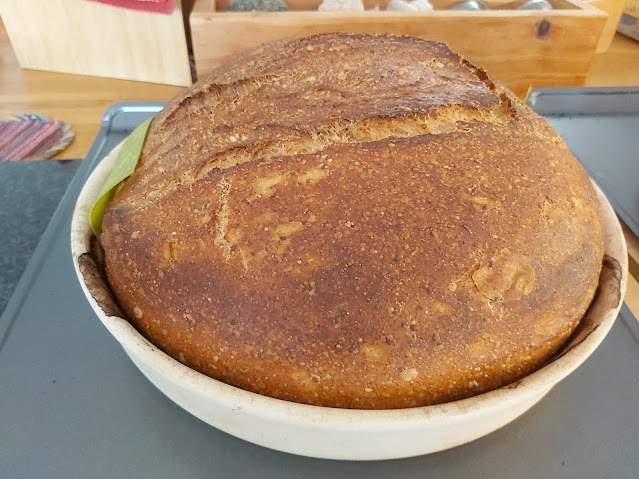Pain de Campagne - using Pâte Fermentée (with baker's yeast)
Welcome to another step-by-step recipe from BreadClub20. Why not drop by our main Facebook page by clicking here.... If you like what you see and enjoy the recipe, we hope you go on to join us by 'Liking' and 'Subscribing'.
Pâte Fermentée is literally 'old dough'. It's a technique popular in France whereby a dough is made using yeast or sourdough cultures and then this is added to a fresh batch of dough for a completely new bake. Once the dough has been rested for ten hours, the French refer to it as Levain de Chef.
Traditionally, bakers would not make Pâte Fermentée as a fresh product...it would be left over from the previous bake. However, rather like the chicken and the egg...it had to start somewhere.
Today, many rural bakers in France use this technique when baking baguettes. In 1993, the French government passed a law, the Décret Pain that stipulated all traditional breads must contain traditional flours, without additives, as well as yeast, salt and water. The dough must not be frozen at any time. Only bread made this way can all itself Une Baguette de Tradition.
The pain de campagne or 'country bread' can be pre-fermented with either sourdough ferment or baker's yeast. It should have a mixture of strong white bread flour and also whole wheat flours. The pain de campagne was traditionally baked once a week in the village oven and loaves could be as large as twelve pounds (5.5 kg), so lasting a family for the whole week.
Today, this recipe is using baker's yeast. It's quite a long process, so clear the decks and let's start.
DAY ONE
Prepare the Pâte Fermentée
400 gms of all-purpose or plain flour
100 gms of wholemeal or whole wheat flour (e.g. wholemeal, rye, einkorn, spelt, etc.)
325 - 375 mls tepid water
1 teaspoon fine sea salt
¼ teaspoon instant yeast
Mix the flours, the salt and the yeast.
Slowly add the water and mix until it is all incorporated.
Add sufficient water and knead until you have a soft, pliable ball of dough.
Transfer the dough to a lightly-oiled bowl, cover and leave at room temperature for about an hour. By then, the dough should have doubled in volume.
DAY TWO
280 grams of strong bread flour
32 grams of wholemeal or whole wheat flour (e.g. wholemeal, rye, einkorn, spelt, etc.)
170 mls tepid water
¾ teaspoon fine sea salt
1 teaspoon instant yeast
 |
| After overnight refrigeration - remember to cut the dough up into pieces and allow to come to room temperature |
Remove the Pâte Fermentée from the refrigerator. Cut it up into about 8 - 10 pieces. Allow the pieces to warm up for about one hour.
Whisk together the flours, the salt and the yeast.
The following is more easily achieved by using either a stand mixer or a bread machine on a pizza dough setting and switching it on and off manually. If you have neither, then it's going to be hand mixing in a bowl.
Place the Pâte Fermentée pieces in a bowl and add the water. Mix together to break up the pieces.
Gradually add the dry ingredients and mix until everything comes together to form a coarse ball.
Keep mixing until you have a soft pliable dough. You may need to add a little more water.
Place the dough in a large bowl, cover and allow to proof for one hour at room temperature.
 |
| Ready for a first proof |
At the end of the hour, stretch and fold the dough a few times. Then re-cover and leave for a further hour.
Remove the dough from the container. You may wish to divide into equal halves and shape each half into a boule. Alternatively, if your containers are suitable large, you could make one large pain de campagne.
Allow to rest for 15 minutes.
BAKING
I'm using Option 2 (a cold bake)
Option 1 : Shape the boules into even tighter boules and place in floured bannetons or in bowls lined with generously-floured tea towels.
Allow them to proof for at least an hour until they are between 1x and 1.5x their original size.
Preheat a Dutch oven or suitable container to 230⁰C. Make sure your containers are large enough to accommodate the dough.
Pop one of the loaves in the refrigerator while you bake its partner.
Score the loaf and place very, very carefully in the hot container. Be careful. Firstly, because the baking pot will be very hot and also because you don;t want to lose the gas that has built up within the second proof.
Mist with water and replace the lid.
Bake for 20 minutes with the lid in place and then for a further 20 minutes without the lid.
Transfer the loaf to a cooling rack and then repeat the process with the second loaf, if applicable
Option 2 : Shape the boules into even tighter boules and place in a cold baking container (cast iron, ceramic or enamelled). Replace the lid.
Allow them to proof for at least an hour or until they are 1x or 1.5x their original size.
Remove the lid, score the dough and then replace the lid. Place in a cold oven set at 230⁰C. When the oven has reached the correct temperature, bake for 20 minutes with the lid in place and then for a further 20 minutes with the lid removed.
Happy baking.
NOTE
If you want to use this recipe but want to use sourdough starter as a pre-ferment, simply ensure your starter is active and then add 60 gms to Day One and another 60 gms to Day Two. Omit the commercial yeast if your starter is nice and active. Then allow longer for the fermentation, 1st and 2nd proof stage (probably at least double the time) and remember to refrigerate overnight.












Comments
Post a Comment